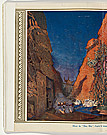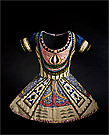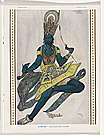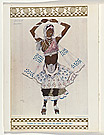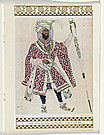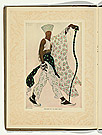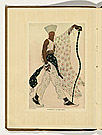Le Dieu Bleu [The Blue God]
Hindu legend in one act
- Producer: Les Ballets Russes de Serge Diaghilev
- Premiere: 13 May 1912, Théâtre du Châtelet, Paris
- Costume design: Léon Bakst
- Costumier: M Landoff and Marie Muelle
- Scenery design: Léon Bakst
- Music: Reynaldo Hahn
- Choreography: Michel Fokine
- Libretto: Jean Cocteau and Federico de Madrazo
- Main characters: The Blue God, the Bayadere, the Young girl, the Goddess,
the Youth, the High Priest, the Peacock bearers
Set in mythical India, the ballet opens at a shrine of the Blue God, which is surrounded by rocks and cliffs with a lotus pond in the centre. Worshippers and a young neophyte, soon to become a priest, gather and wait for the ordination ceremony to commence. After the high priest arrives the ceremony begins but is interrupted by the novice’s lover, attempting to rescue him from priesthood. She is captured and imprisoned in the shrine, where she threatened by its resident monsters. While trying to escape she inadvertently lets loose a plethora of monsters. She appeals to the shrine’s deity for help and the Blue God and Goddess both rise from the lotus pond. The Blue God subdues the monsters, the lovers are reunited and the gods return to their celestial abodes.
The orientalist exoticism of Cléopâtre and Schéhérazade continued in Le Dieu bleu. Bakst’s set, with its massive carved faces, showed the influence of those of the Bayon Temple of Angkor Thom in Cambodia, which had been popularised in France through engravings in Louis Delaporte’s Voyage au Cambodge: l’architecture Khmer (Voyage to Cambodia: Khmer architecture), published in Paris in 1880. The French fascination with the cultures of its colonies had given audiences the opportunity to see several troupes of Cambodian court dancers in performance at the 1906 Colonial Exposition in Marseille.3 Earlier, in 1900 a troupe of Siamese dancers had performed in St Petersburg, forming an impression on Fokine that would take form in his choreographic work on Le Dieu bleu. These influences are encapsulated in Bakst’s design of the original skirted costume for the Blue God (Krishna) worn by Nijinsky. Made of watered silk and satin, it is embroidered with a closed lotus flower and rays of gold thread and metallic studs. The stiff conical skirt’s background fabric is a contemporary printed pattern, overlaid with embroidered arabesques, while its hem is decorated with pearlised pink and white gelatin discs. The intricately decorated bodice was most likely designed to suggest the body jewellery seen in Hindu sculpture, while the stiff formality of the costume was echoed in Nijinsky’s performance of sculptural poses rather than active dancing. As Krishna, Nijinsky had worn bright blue make-up in continuance of the tradition of the god’s skin being turned blue as a result of being bitten by a poisonous serpent. Traces of this blue make-up are impregnated in the lining of the costume, giving it a particularly intimate connection to Nijinsky.




